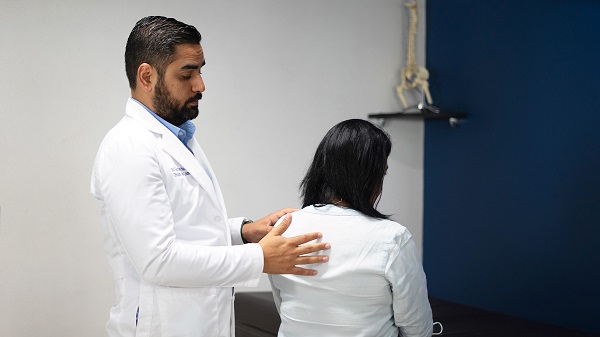Dr. Gustavo Navarro is a back and spine Specialist and Spinal Surgeon using Minimally Invasive Treatments helping patients who suffer from back pain caused by conditions and accidents.

Surgery for sciatica is usually considered when leg pain and/or weakness is persistent or progressive even after several methods of non-surgical sciatica treatments have been tried. In a few cases, surgery may be considered as the first option.
A few examples where surgery is considered as a first option are:
- Cauda equina syndrome—a medical emergency where nerve roots of the cauda equina are compressed and motor and sensory function in the lower body are lost.
- Tumors, collection of fluid (cyst or abscess), or severe fractures in the lumbar spine
- Bilateral sciatica—sciatica affecting both legs, may be caused by multiple level disc herniation, severe single level herniation, or central spinal stenosis.
- Infection in the pelvic region that does not respond to medication.
In addition, surgery may be considered when leg pain and/or weakness persists for more than 6 to 8 weeks despite nonsurgical treatments and/or when pain affects everyday activities.
Surgery is performed with the goal of eliminating the cause of sciatica and to control the leg symptoms such as pain and weakness. Back pain associated with sciatica, however, may not improve after surgery.
Microdiscectomy for Sciatica
Microdiscectomy is a common surgical approach used to treat sciatica that is caused by a lumbar disc herniation. In this surgery, a small part of the disc material under the nerve root and/or bone over the nerve root is taken out. While technically an open surgery, a microdiscectomy uses minimally invasive techniques and can be done with a relatively small incision and minimal tissue damage.
Research shows up to 86% of patients may experience sciatica pain relief after a microdiscectomy surgery.
Lumbar Decompression Surgeries
A number of surgical approaches are available to relieve various sources of nerve root compression or irritation, such as:
- Laminectomy. In this procedure, part or all of the lamina is removed in order to provide more room for the spinal nerves. It is most commonly done for sciatica pain caused by lumbar spinal stenosis. An estimated 75% to 90% of patients may experience pain relief after lumbar laminectomy surgery.
- Foraminotomy. In this procedure, the neuroforamen is enlarged by removing bony overgrowth, providing more room for the nerve root as it exits the spinal column through this opening.
- Facetectomy. This surgical procedure used to relieve compression on pinched nerves caused by degenerated facet joints. The facet joints are typically trimmed, undercut, or removed to relieve nerve pressure. It is estimated that 85% of patients may experience pain relief after a facetectomy surgery.
As appropriate, these procedures may be combined and performed at the same time. For example, a laminectomy procedure may be done along with a foraminotomy, and the surgery is called a laminoforaminotomy. Additional procedures may be done in combination with the above, include osteophyte (abnormal bone growth) and/or hypertrophic (overgrown) ligament removal.
As with any surgery, a number of risks are possible, including but not limited to a risk of nerve or spinal cord damage, bleeding, infection, clot formation, and continued symptoms post-surgery.
Research suggests that surgery for sciatica may provide better reduction in pain and improvement in functional outcome for up to 1 year as compared to nonsurgical treatments. However, in the long term (4 to 10 years), the outcome for both approaches are usually similar.1
The decision to have surgery for sciatica pain is typically a patient’s choice unless there is a medical emergency, such as cauda equina syndrome. The patient’s decision to have surgery is based primarily on the amount of pain and dysfunction, the length of time that the pain persists, the patient’s overall health, as well as the patient’s personal preference.

The primary purpose of back surgery or neck surgery is to correct an anatomical lesion in individuals who fail to show improvement with conservative (nonsurgical) treatment. Surgery is not an option for patients when an anatomical lesion accounting for their pain can not be identified.
Surgery is only useful to change a patient’s anatomy (e.g. remove a disc herniation). There is almost never any reason to consider exploratory surgery to “look” for a cause of pain.
Failing conservative treatment is not in and of itself an indication for surgery. An identifiable anatomic lesion is also necessary.
Advancements in Spine Surgery
Modern spine surgery has made major advancements in both technique and spinal instrumentation/implants over the past couple of decades, but by far the most significant advancement in spine surgery has been better preoperative imaging techniques, which have greatly improved the ability of surgeons to identify accurately and correctly an anatomic lesion as a cause of pain.
Specifically, magnetic resonance imaging (MRI scan) has revolutionized back surgery. It is most often the best test to identify an anatomical lesion responsible for the patient’s problem.
The most important factor in the determination of the success in spine surgery is proper preoperative diagnosis. Without an accurate preoperative diagnosis, even the most technically successful surgery has little chance for a successful outcome.
Although spine surgery is performed by either orthopedic surgeons or neurosurgeons, it is increasingly becoming a field unto itself. Many surgeons are doing additional specialized training in the field after their residency training (fellowship training).
Given the precision required for these more demanding surgical techniques, many orthopedic surgeons or neurosurgeons with fellowship training are choosing to focus more of their practice on spine surgery. Some believe that the increased level of specialty training and focus on the spine has contributed to enhancements in surgical technique, which in turn has led to overall improved success rates and reduced morbidity (e.g. reduced post-operative discomfort) with many types of spine surgeries.
Reasons for Spine Surgery
Spine surgery is typically an “elective” undertaking, meaning that it is considered as a possible approach to enhance a patient’s ability to function and decrease pain. However, just because spine surgery is elective does not mean it is not covered by insurance.
Elective surgery can be medically necessary. «Elective» just means that surgery of the spine is rarely an absolute necessity. Only in rare instances, such as for patients who have a progressive neurological loss of function or sudden onset of bowel or bladder incontinence, is spinal surgery actually necessary on an emergency basis.
Spine surgery can basically accomplish three tasks:
- Decompress a nerve root or the spinal cord
- Stabilize an unstable or painful segment with spinal fusion surgery
- Reduce a deformity (e.g. scoliosis surgery in the thoracic spine).
Spine surgery is not done for exploration. The cause of a patient’s pain is not readily apparent with opening and exploring the spine. The preoperative evaluation and imaging results are what identify the problem and guide the design of the procedure.

Lumbar surgery refers to any type of surgery in the lumbar spine, or lower back, between one or more of the L1-S1 levels.
There are two general types of lumbar spine surgery that comprise the most common surgical procedures for the lower back:
Lumbar Decompression
The goal of a decompression surgery is usually to relieve pain caused by nerve root pinching. There are two common causes of lumbar nerve root pressure: from a lumbar herniated disc or lumbar spinal stenosis.
This type of pain is usually referred to as a radiculopathy, or sciatica.
A decompression surgery involves removing a small portion of the bone over the nerve root and/or disc material from under the nerve root to relieve pinching of the nerve and provide more room for the nerve to heal. The most common types of decompression surgery are microdiscectomy and laminectomy.
There are also a few alternatives available to the above two standard procedures, such as an X-STOP which is a possible option instead of a laminectomy for lumbar spinal stenosis.
Lumbar Fusion
The goal of a lumbar fusion is to stop the pain at a painful motion segment in the lower back. Most commonly, this type of surgery is performed for pain and disability caused by lumbar degenerative disc disease or a spondylolisthesis.
A spinal fusion surgery involves using a bone graft to stop the motion at a painful vertebral segment, which in turn should decrease pain generated from the joint. Spine surgery instrumentation (medical devices), bone graft procedures, and a bone stimulator are sometimes used along with spinal fusion.
There are also many surgical approaches to performing spinal fusion, such as ALIF, PLIF, XLIF, TLIF, posterolateral gutter fusion, anterior/posterior fusion, and certain minimally invasive approaches.
In addition to the above conditions, decompression and/or spinal fusion may be performed to address other types of lumbar spine pathologies, such as infection or tumors.
Learn More
Leadership
Locally recognized in Puerto Vallarta for being a leader in Minimally Invasive Spinal Surgery.
- Modern Operating Rooms – CMQ Bucerias is a specialized hospital that meets all the standards.
- Comfortable Recovery Rooms – After surgery, your comfort will assist your healing process.
The root of back pain
Pain and other symptoms can develop when the damaged disc pushes into the spinal canal or nerve roots. Also, back pain can be caused by a more serious injury, illness, or conditions like osteoporosis, spinal stenosis or herniated discs and should be evaluated by a physician who specializes in spinal care. While many health care providers can treat the symptoms of back pain, spine specialists are experts at diagnosing and caring for the underlying symptoms that are causing or contributing to the problem.
5 signs it's time to see a spine specialist
- Chronic pain of varying degrees that lasts for 12 weeks or longer, even if you’ve sought treatment for the primary cause.
- The pain is getting in the way of living your life. Are you missing work? Unable to exercise like you once did? Does it hurt just to get out of bed in the morning?
- Foot or leg weakness or numbness with or without accompanying bladder or bowel issues. This could be a sign of a compressed nerve or disc herniation.
- You are unstable on your feet, aren’t able to walk far without pain, or continue to have back pain while sitting, standing or laying down.
- You have limited range of motion (unable to bend over, twist sideways or stand up straight without pain).
Conditions We Treat
- Neck & lower back pain assessment
- Herniated disks
- Sciatica
- Bulging disks
- Degenerative disk disease
- Spinal fractures and tumors
- Spinal stenosis
- Osteoporosis
- Scoliosis

────
Telemedicine appointments with Dr. Gustavo, are now available and Medical Insurance – Accepted.
Certifications
Dr. Navarro is Certified by the Mexican Federation of Colleges of Orthopedics & Traumatology
- View Medical Degrees
- ATLS Course, Mexico City, Mexico. 2014.
- AO Trauma Basic Course of the Principles of Fracture Treatment, Guadalajara, Mexico. 2015.
- XXIX International Congress of the Mexican Society of Pediatric Orthopedics and Traumatology SMOP, Guadalajara, Mexico. 2015.
- XV Symposium of Pediatric Orthopedics “Dr. Newton C. McColloug, III ”, Mexico City, Mexico. 2016
- AO Trauma Advanced Course on the Principles of Fracture Treatment, Guanajuato, Mexico. 2016.
- XVII International Meeting of the Mexican Society of Hip Surgery SMCC, Monterrey, Mexico. 2017.
- AO Spine Regional Courses, Principles Course, Mexico City, Mexico. 2017
- XVIII National Congress of the Mexican Association of Spinal Surgeons, Acapulco, Mexico. 2017.
- Multidisciplinary Course on Spinal Microsurgery, Guanajuato, Mexico. 2018.
- XIX National Congress of the Mexican Association of Spinal Surgeons, Cancun, Mexico. 2018.
- Fellowship in Endoscopic Spinal Surgery and joined the CMQ Physician Staff in 2019.
- Learn more about Spine Surgery.
- View Professional Affiliations
- Surgeon Endorsed by the Autonomous University of Guadalajara, Veracruzana University and the Mexican Federation of Orthopedic and Traumatology Colleges.
- Fellowship of Spine Surgery at the National Institute of Traumatology and Orthopedics of Rio de Janeiro, Brazil. Endorsed by AOSpine.
- Fellowship of Minimally Invasive Surgery and Vertebral Reconstruction Techniques, – Endorsed by the Instituto de Columna of Rio de Janeiro, Brazil.
- The Mexican Federation of Colleges of Orthopedics and Traumatology FEMECOT.
- Mexican Association of Spine Surgeons AMCICO. AOSpine.
- North American Spine Society NASS.
Online Consultation
If you are not currently in Mexico but would like an online consultation, fill out the form below to set up a meeting.

ADDRESS
Av. Héroes de Nacozari 280 Bucerías, 63732 Riviera Nayarit, Nay.
HOURS OF OPERATION
Monday – Saturday: 9 am – 6 pm
Back Surgery: Pros and Cons
What Are the Benefits?
Often, the result is more than just a drop in pain. You may find:
- You can move around better.
- You’re more physically fit.
- Your mood improves.
- You don’t need to take as much pain medicine.
- You can go back to work.
- You’re more productive at work.
Are There Risks?
Most people who get back surgery have minimal, if any, complications.
That said, any operation has some degree of risk, including:
- Reaction to anesthesia or other drugs
- Bleeding
- Infection
- Blood clots, for instance in your legs or lungs
- Heart attack
- Stroke
- Herniated disk
- Nerve damage, which can lead to weakness, paralysis, pain, sexual dysfunction, or loss of bowel or bladder control
The odds that something could go wrong go up for people with certain health conditions. They also vary by type of surgery. Part of your surgeon’s job is to identify potential problems. So talk it over before you head to the OR.
Back Surgery Pros and Cons
Each type comes with its own risks and benefits.
Spinal fusion. This is the most common surgery for chronic nonspecific back pain with degenerative changes. The doctor will join spinal bones, called vertebrae, together. This limits the motion between them and how far your nerves can stretch. But it probably won’t limit your activity. It’s rare, but the bones don’t always fuse completely. Smoking can make this complication more likely. If it happens, you may need another operation to fix it.
Laminectomy. This is the most common surgery for lumbar spinal stenosis. In this procedure, a surgeon removes parts of the bone, bone spurs, or ligaments in your back. This relieves pressure on spinal nerves and can ease pain or weakness, but the procedure can make your spine less stable. If that happens, you’ll probably need a spinal fusion as well. Doctors sometimes do the two procedures together.
Best Mattress for Lower Back Pain
It Needs to Keep Your Spine Aligned
You may not realize it, but good posture is important when you sleep. The muscles and ligaments (tissue that holds joints together) in your back need to relax and recover while you snooze. If a mattress is too firm — or too squishy — it won’t support your spine at your neck or lower back the way it needs to. What’s firm enough (but not too firm) is different for everyone: If you have wide hips, for instance, a slightly softer surface may be better. You need some more give in order to keep your spine in alignment. Someone with narrower hips might be better off with a firmer surface.
When in Doubt, Go ‘Medium-Firm’
Research is limited, but in one study, researchers assigned new mattresses to more than 300 people with low back pain. They used either “medium-firm” or “firm” mattresses for 90 days. Those in the medium group reported the least amount of discomfort.
You might consider getting a memory foam mattress (instead of a traditional innerspring one). The foam molds to your body. The downside: Some memory foam mattresses keep in heat; and the material might have more chemicals.
Take a Longer Test-Drive
If you have a great night’s sleep and wake up pain-free after staying at a hotel or in a friend’s guest room, copy down that mattress’s model number. Or choose a mattress that comes with a money-back guarantee: A growing number of companies will let you buy a mattress and use it for anywhere from 30 to 100 days and send it back for a refund if you’re not happy with it.
Just Buy Something
When researchers from Oklahoma State University randomly assigned 62 people to sleep in a variety of new beds for 28 days, they found that almost everyone started to sleep better. That was true regardless of which model they were given, though people who slept in the cheapest beds did report more lower back pain than those in the medium- and higher-priced beds.
The most important thing seemed to be that the beds were new. They noted that the average age of the participants’ old beds was 9.5 years. And they concluded that “sleep quality may be dependent on timely replacement of bedding systems.” The takeaway: If you’ve been sleeping on the same mattress for 9 or 10 years (or more), it’s time to get a new one. Almost any new replacement is going to be better than the saggy foundation of an old mattress. But it may pay to spring for at least a mid-priced model.
Pillows and Positions Matter
Even if you have the right mattress, it’s not the only thing that counts when it comes to managing your back pain as you rest. Sleep position is important, as are the kind of pillows you use and where you place them.









